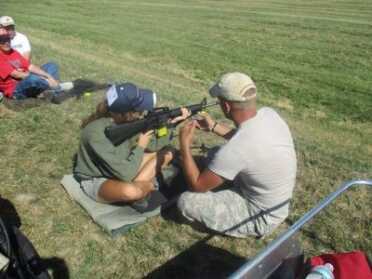
F-Class rifle, in candy apple red, with a nice rest and gorgeous machining on the bolt — a long-range shooting hot rod!
Introduction:
This trip into competitive shooting is going to be all about the rifle, specifically, High Power Rifle, a kind of competition and class of rifle. This is what I grew up on, it’s where my journey into competitive shooting began; Service Rifle with an M-14. It’s where I learned the most about reloading and where I became totally aware of how critical good sight alignment is. It’s also where someone once told me I should shoot IPSC because I was fast at clearing malfunctions in rapid fire strings while still getting all my shots off (I still remember shooting that day — it foreshadowed my personal shooting story).
- Ep. 1 Getting Started
- Ep. 2 Steel Challenge
- Ep. 3 USPSA Pistol
- Ep. 4 Shotgun
- Ep. 5 3 Gun
- Ep. 6 High Power Rifle
- Ep. 7 Cowboy Action
- Ep. 8 Shotgun II
- Ep. 9 IDPA
- Ep. 10 Bulls Eye Pistol
- Ep. 11 Smallbore Rifle
What is High Power?

When you’re not shooting, you have to take a turn scoring. This means watching through your spotting scope to look at the target, verify it was pulled and score, and write down the correct score. Being a good scorekeeper is important in Highpower. Poor ones are not well liked.
What is High Power Rifle?
High Power Rifle is sometimes referred to as “across the course” rifle. The NRA rulebook has all the details, but what you shoot falls into two main categories: Service Rifle — M16, M14, M1 Garand in nostalgia matches, all with iron sights — and Match Rifle — usually a bolt rifle with aperture sights.
I love High Power not because it’s flashy — it’s anything but that — but because it teaches the meat and potatoes of marksmanship. In High Power, you won’t find the eye candy you’ll find in action shooting sports, e.g. flamboyant jerseys or fast-paced movement. But while it’s not showy, it requires refined skills that many people never master.
Honestly, my boys prefer 3-Gun to High Power, but they still value it as a cross-training discipline, knowing that the skill gained from applying the fundamentals of shooting a rifle will carry over to the other avenues of shooting sports. For example, the fundamentals learned in High Power have allowed them to use iron sights and make hits out past a thousand yards.
Don’t get me wrong, High Power is exciting! It’s exciting hitting shots in the 10 and x ring at 600 yards. It’s exciting to know how to read and estimate windage; how to watch the trace of the bullet and learn where it’s going to impact based on what you see. It’s exciting when you learn to back your scope off and see the mirage roll over or boil and use that as a tool to physically see what you can feel happening with the wind, and translate that into actionable steps that will help you make a hit on target.
The Gear You’ll Need
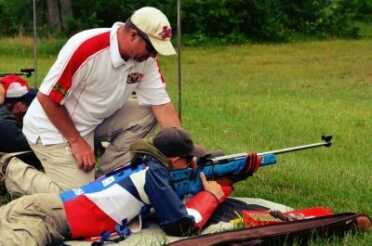
Stiff leather jackets, and sweatshirts underneath make for a need to hydrate on hot summer days on the highpower range.
High Power is not very gear-intensive. You need a rifle, sling, ammo and a spotting scope to start. The most basic of gear that I used was my M-14, a leather sling, a glove, shooting jacket, combat boots (or my bare feet), my data book and wind charts, a carbide lamp and a shooting mat. Shooting with iron sights drives home the importance of focus, in that you need to focus on your sights, trigger control and many small things that can be overlooked in other shooting disciplines. So take the time to learn basic fundamentals and how to apply the minutia contained in them to an obsessive-compulsive level that a good performance in High Power demands. This will teach you more about control than most other disciplines can.
If you decide Service Rifle isn’t for you, there are options: Match rifle, Palma Rifle and F-Class are alternatives. Your gear list will be tweaked just a bit. You’ll be allowed to use a forend stop for Palma and you can use a bipod or rest in F-Class, as well as optics. This is a great help for shooters whose eyes cannot work with iron sights at distance.
Service Rifle: Usually an M16, M14, or M1 Garand rifle, with peep rear sight and post front sight. A leather sling, and glove are the only accessories you need. There are changes to Service Rifle to allow for what is seen in modern service rifles, namely, adjustable stocks and optics.
Match Rifle: The main difference from Service Rifle to Match Rifle is that Match Rifle allows for aperture sights on front and rear, a stop for your forearm to keep your hand placement the same every time, and a cuff on your sling. You also see different calibers, such as .243 Winchester.
Palma Rifle: Palma has a history dating back to 1874. A Palma match consists of 15 shots at each of three distances: 800 yards, 900 yards, and 1000 yards. These rifles will fall under the “Match Rifle” configuration with aperture sights, adjustable stocks, forearm stops, etc. And the rules call for: “(a) a rifle with metallic sights chambered for the unmodified .308/7.62 mm NATO or .223/5.56 mm NATO cartridge case. or (b) any service rifle with metallic sights chambered for the unmodified .308/7.62 mm NATO or .223/5.56 mm NATO cartridge case.”
F -Class Rifle: This class allows any rifle up to 22 lbs. Target ranges are similar to Palma, 600 to 1,000 yards, and you can use a rest, as well as an optic. Shooters can use almost any rifle caliber, up to .338, and they can shoot any load they want – usually pretty hot, so the term “hot rod” is no joke!
Minute of Angle (MOA)

View through a spotting scope at the targets in a Palma Rifle match during Midwest Long Range Championship, 2014.
6 -12-24. That was my sight adjustment for 200, 300, and 600 yards. In my years of shooting High Power, that was my elevation and really all that I needed to check until I took my sighter shots. I applied some wizardry in the form of the old adage about “lights up, sights up” and would use 8 and 13 and 25 on sunny days. But really, once your rifle is zeroed, knowing your elevation changes is the biggest piece of information needed, and it’s rewarding to internalize and utilize such a basic set of data to shoot accurately.
Those clicks on a sight represent minutes of elevation and they relate to what adjustment range your sight has. A Minute of Angle (MOA) is a measurement, and it’s 1/60th of a degree. So at 100 yards, it’s 1 inch (actually, 1.047 inches), at 200 yards, 2 inches, and so on. Knowing how it work is what’s important. For a detailed explanation, check out this awesome GunsAmerica article Minute of Angle (MOA) Accuracy Out of the Box or this video from the National Shooting Sports Foundation (NSSF) for an explanation.
You use MOA as a basic way to measure a target and then calculate for adjustments in sights to move your impact to hit the target. MOA can be broken down further, you can look at half minute of angle or a quarter minute of angle. The most important part of this math is knowing what your sights or optics adjust in. Usually it’s half or quarter minute clicks.
One other bit of info: I wouldn’t go to a High Power match without is a good wind chart. My first exposure to High Power was in a class taught by former Marine, Jim Owens, and he had a great set of wind charts that we used. Understanding how much windage to dial on your sights is important, and you need to make a well-educated guess before your sighters.
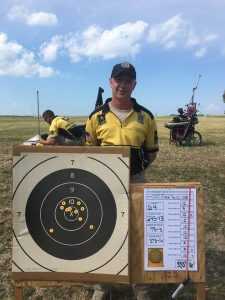
Sgt. 1st Class Evan Hess of the Army Marksmanship Unit (AMU) at Camp Perry, in the President’s 100. His 300yd rapid-fire rifle string – 10 rounds in 70 seconds.
High Power Format
High Power is generally a National Match Course (NMC): either 50 shot NMC or 80 round NMC. This includes 200-yard standing, 200-yard rapid-fire sitting, 300-yard rapid-fire prone, and 600-yard timed fire prone. For the exact times on each yard line, read here. For Palma Rifle, you shoot 15 rounds, prone at 800, 900, and 1,000 yards, for a total of 45 rounds for record.
In a National Match Course, the targets you engage are paper, and the black measures 13 inches at 200 yards, 19 inches at 300, 36 inches at 600 yards. For Palma Rifle, the targets are at 800, 900, and 1000 yards, and the black is considerably larger – 44 inches.
You can have hits outside the black, and this article has a nice detail of the target and sizes.
What to expect on match day:
First, sign in, get your squadding and head to the appropriate place, either shooting, pulling targets in the pits, or scoring. If you’re shooting, you put your prone mat and gear at your firing position, set your gun case up next to it, set up your scope and get ready for when the line goes hot.
If you’re in the pits, pull your target down, check it over, paste any holes or put a new center on. Get your pasters, markers to mark hits, and other supplies ready and put your target at half-mast to indicate you’re ready to the line officer.
If you’re scoring, ask for the shooter’s scoresheet, set your spotting scope up, and be ready to watch for a couple points. First, that the target goes down after each hit, and second, that the target comes back up. If a person is shooting consistently, and you miss it going down and coming up, you could cost the person a hit because you failed to watch target get pulled. The shooter is recording their call, and loading their next round, they might not be watching and if their hit is the same as the last, the marker on the target might only move a couple inches, so you have to watch closely.
In the pits, you will hear a crack as it goes through the target, and based on where it impacts, you will know which side of the target it’s on. With a person in the pits that works fast along with a consistent shooter on the line, the string of fire can go very fast.
Be courteous and be sure to be on top of things as a scorer. Your shooter wants to shoot in the constant of the wind, so if they’re continuing to shoot, be on the ball. The same thing pulling targets — the shooter on the line deserves the same respect you want, so be sure to watch the impact area and pull fast, and have the paster for the next shot ready and spare markers handy. One of the most frustrating things as a shooter is having a slow target puller if the wind is shifting.
The Big Picture on Positions
The biggest component of High Power shooting positions is using your bone structure and building each position to allow your natural point of aim and the manipulation of the sling to let the rifle settle where it needs to be pointed, and to do this in a repeatable manner. Natural point of aim is very important in High Power, and if you drop into seated position and your natural point of aim is off, your group might end up off to one side of the target.
Basic Position Standing
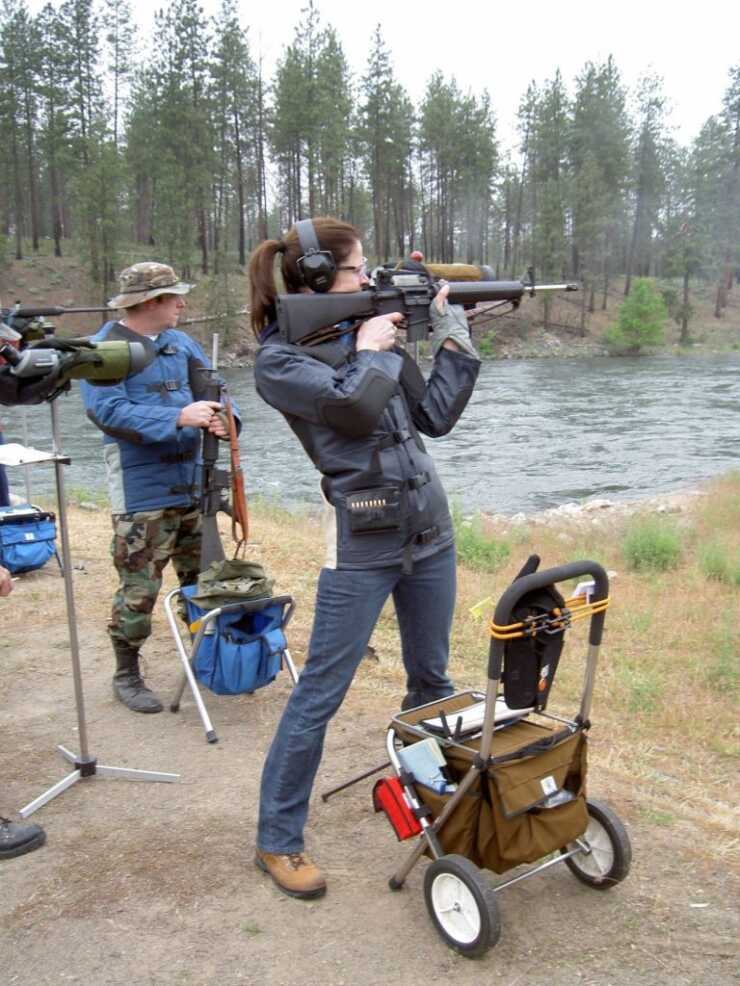
Anette Wachter, shooting standing Service Rifle. Note her left arm against her body, and her hand on the rifle under the sling, in front of the magazine.
Stand facing perpendicular to firing line, feet shoulder-width apart. Your left arm will usually be against your body, supporting the rifle, often in front of the magazine (see the picture of Anette Wachter, of the US Palma Team), or if you’re short, on the magazine, and the right arm pulls the rifle back into your shoulder.
You will bring the rifle up the same way each time, and your goal will be to have a natural point of aim that is on the target.
You can slide a single foot forward or backward, or point your toes inward or outward to adjust your left to right. To adjust up and down, you can narrow or widen your stance by sliding your feet closer together or further apart.
Basic Position Sitting

Seated position at 200 yards can vary from person to person, but with good technique, the shooter can be locked in solid. Notice the shooter’s elbows are inside the knee on either side — on the flat spot just inside the knee and at the top of the shin.
Start facing at about a 45-degree angle to the target and extend your legs, for a right handed shooter, this means you’re seated facing about 2 o’clock with the target being at 12 o’clock.
Cross your legs and drag them back toward you until your ankles lay flat and you have a solid position to lock into, with elbows on knees, in the sort of pocket on the side of the knee. Alternatively, you can cross your legs more, like Anette does in the photo above.
Basic Position Prone
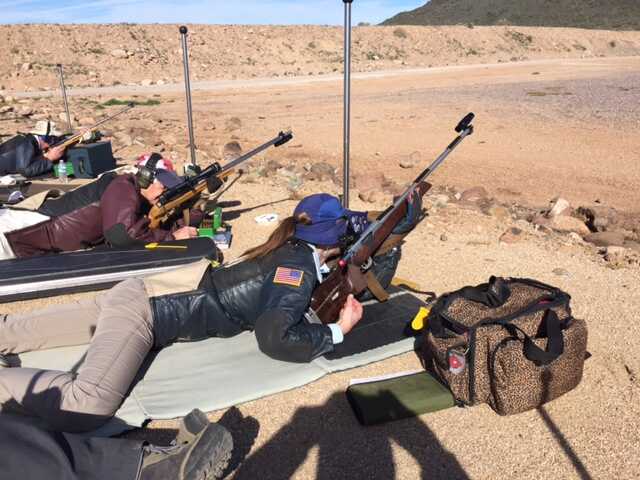
Prone position: shooter is set up so they can stay in position while they roll to look through their scope, and then return to shooting with minimal movement.
Your goal is to again, have a good natural point of aim, and to shoot each shot in exactly the same manner. The best prone technique is to lay so that you’re off your diaphragm. To achieve this, lay more to your left side (if you’re a right-handed shooter) and bring your right knee up. This will help keep your breathing from effecting your sights.
A consistent hand position on your forearm in the sling as well as a consistent cheek weld will also help ensure you repeat each shot.
Big things from tiny little sights
The big things a shooter can take away from learning to shoot a rifle in High Power competitions center on fundamentals of marksmanship. Here are my biggest takeaways:
Accept the wobble: Shooting standing at 200 yards teaches you to defy expectation, and to accept your wobble. People who’ve never shot 200 yards with iron sights have no idea what wobble means. It’s a fluid thing — breaking a shot with iron sights. The control comes in the finesse in which each part of the process — shooting position, sight alignment, trigger control, and follow-through — are all put together.
Sight alignment: If nothing else, Service Rifle will teach you that sight alignment is of the utmost importance! If I have my sights aligned and squeeze the trigger when I’m not holding perfectly on the target, I might have an 8, but if I don’t have them aligned, my shot will impact much further from where I intend. I roll this knowledge over into 3-Gun and shooting with an optic, knowing that my scope can’t have a shadow in one side, or I’m basically accepting a sight picture that is NOT aligned. Sight alignment gets more critical the further away from a target that you are.

Anette Wachter, member of the US Palma Team, shooting prone.
Trigger control: Don’t be a jerk. I might be able to jerk the trigger at 50 yards, but when I get to 300 or 600, I’m going to need proper trigger control and follow-through in order to shoot effectively. To make a hit at 600 yards, you need control; in how you break the trigger, and in follow-through — staying on the gun past the point where you break the shot. This is in contrast to what I do in 3-Gun, and makes me see that, again, cross-training is important! I can’t focus on one thing ignoring smaller components of the process — I need to know that a further shot requires a very different trigger pull, break and reset than a shot at close distance. And I need to hold myself to applying the correct trigger pull where it fits.
Every American is a Rifleman
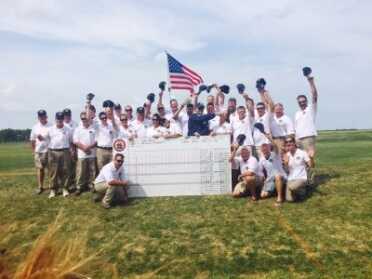
US Palma Team, 2015 World Palma Championships.
High Power resonates with me because I think it harkens to the very core of the Second Amendment, “A well-regulated militia being necessary to the security of a free state, the right of the people…” to have guns, to shoot them, and to be proficient in them, for the security of their country and freedom is something good and holy!
The High Power rifle of 1776 was a black powder musket. In our day, the rifle of choice is the AR-15. The Civilian Marksmanship Program is probably the closest thing America ever had to the concept of arming its citizens, like the Swiss have done. It began in 1903 with the goal of providing firearms safety training, as well as create a pool of potential marksman, should there be a draft. The focus on youth was centered around the fact that young people who learn how to use a rifle could defend their country. The awards for shooting accomplishments are also part of the military excellence in competition badge, and the U.S. Military recognizes scores from sanction CMP events. The CMP not only teaches firearms safety to civilians, but it plays a role in our nation’s defense preparedness.
Small Arms Clinic
If you live near Camp Perry the Small Arms Firing Clinic that is held there each year is a great place to learn about highpower rifle! Check out the Civilian Marksmanship Program’s website for more info: https://thecmp.org/learn-firearm-fundamentals-at-2016-national-matches-small-arms-firing-schools/
[one_half]
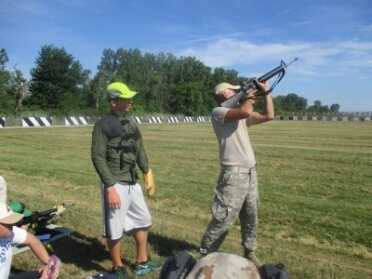
Small Arms Firing School, run by the AMU at Camp Perry, is a great experience for any new highpower shooter.
[/one_half]
[one_half_last]
[/one_half_last]
***
About the author: Becky Yackley has been shooting competitively since she began as a teenager with Service Rifle and smallbore. She’s lived near the typical Marine Corps bases and spent 10 years near DC while her husband was active duty, and today has settled into Wisconsin and shooting 3 Gun, USPSA, and Bianchi pistol with her three boys and husband. An avid runner and outdoorswoman, she shoots guns and photos, and sometimes her mouth…which her friends often remind her keeps them “alert” at late hours on road trips. Never known for being quiet, she’s bringing her brand of humor our way this year in hopes of sharing her love for shooting sports with our readers.


